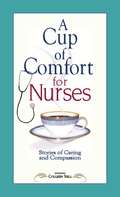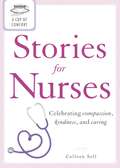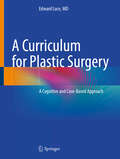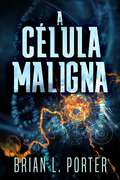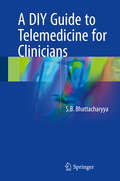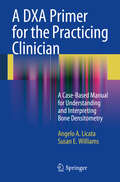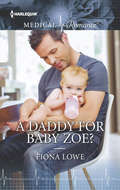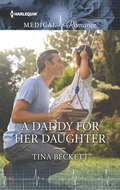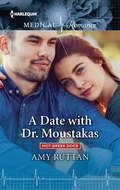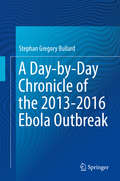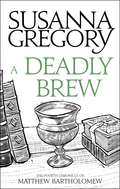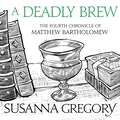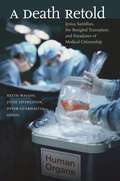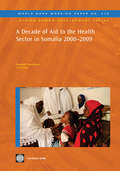- Table View
- List View
A Cup of Comfort for Nurses
by Colleen SellDoctors have long been considered the heroes of the medical profession. Yet it is the nurses who are there for us at birth, death, and every bump, bruise, or break in between. A Cup of Comfort for Nurses brings the tales of more than fifty of these underappreciated professionals to life, including: Bonnie, who along with one of her fellow nurses, became known to her patients as "Comfort and Joy"; Julie, who became a nurse (along with four of her siblings) after caring for a physically and mentally delayed sister in her home under the guidance of her doting mother; Dot, who served her country during World War II by caring for injured soldiers home from the front. The moving tales of these dedicated nurses, along with the dozens of others in A Cup of Comfort for Nurses are sure to appeal to readers everywhere-and may even inspire some of them to take up the nurses mantle themselves.
A Cup of Comfort for Nurses: Stories of Caring and Compassion
by Colleen SellThe moving tales of these dedicated nurses, along with the dozens of others in a Cup of Comfort for Nurses are sure to appeal to readers everywhere-and may even inspire some of them to take up the nurses mantle themselves.
A Cup of Comfort for Nurses: Stories of Caring and Compassion
by Colleen SellA Simon & Schuster eBook. Simon & Schuster has a great book for every reader.
A Cura Energética do Reiki: Um Livro para Iniciantes para um Melhor Entendimento
by Lewis Haas Johann PiresAprenda como Mudar Profundamente sua Vida com a Poderosa Arte de Cura do Reiki Você gostaria de se sentir fisicamente e emocionalmente energizado? Você precisa se livrar da ansiedade e da depressão? Você pode imaginar se sentir mentalmente e emocionalmente mais forte? E se você pudesse se aliviar das dores físicas e emocionais? Você gostaria de liberar antigos traumas e finalmente curar a si mesmo? E se você pudesse perceber que você vale a pena, achasse um caminho em sua vida para se ver livre de raiva, preocupações e dúvidas? Você gostaria de cultivar uma saúde vibrante para você e para outras pessoas também? A solução é simples e natural – Reiki. Depois de ler “A Cura Energética do Reiki: Um Livro para Iniciantes para um Melhor Entendimento” você saberá o que Reiki é e como receber seu poder. A arte de cura do Reiki é uma maneira incrível de criar uma vida cheia de saúde, felicidade e abundância. “A Cura Energética do Reiki” inclui: •Como o Reiki afeta positivamente o doador e o recipiente •Como ajuda você a se tornar seu melhor Eu •Descubra como o Reiki funciona para você e para quem você ama •Perceba seus pontos fracos e equilibre-se •Melhore seus cuidados com a saúde •Símbolos Reiki e técnicas para liberar situações do passado, curar traumas, perdoar outros, eliminar bloqueios emocionais, criar poderosos novos hábitos e atrair abundância •Os passos para como você pode se tornar um praticante de Reiki •Se tornando um profissional Reiki de sucesso •Respostas para perguntas frequentes e enganos sobre Reiki •A história e fatos intrigantes sobre Reiki •Entenda um pouco das mais avançadas técnicas •E muito mais! Com Reiki, A Qualidade Da Sua Vida Está Para Melhorar – Revolucione Sua Saúde e Sua Vida De Uma Maneira Natu
A Curriculum for Plastic Surgery: A Cognitive and Case-Based Approach
by Edward LuceThis book offers a comprehensive curriculum on plastic surgery, centered on adult learning principles. The pedagogical structure includes a base of cognitive knowledge that consists of the entire spectrum of plastic surgery; reconstructive and aesthetic; a guide for an interactive discussion of each component of the knowledge base; a set of multiple-choice questions with a syllabus of explanation of correct and incorrect responses; and clinical cases to illustrate each element. Over one hundred modules constitute the curriculum, all of which are grouped into thirteen general categories. Each module includes a selected bibliography of relevant and contemporary readings, a discussion guide of broad questions and answers for a faculty member to drive an interactive discussion of the module, a set of multiple-choice questions for each module to serve as a short written quiz, and 1-3 cases that are utilized in a case-base conference to discuss the practical application of cognitive knowledge to problem-solving of a clinical scenario. Finally, a several-page review of the particular case provides an optimal approach to diagnosis and treatment. A Curriculum for Plastic Surgery provides an encyclopedic yet facile vehicle to deliver a comprehensive, contemporary, and interactive curriculum. The curriculum reflects the author’s four decade long career in academic practice and teaching within this field.
A Célula Maligna
by Brian L. PorterUm grupo de mulheres se reúne em uma clínica de fertilidade belga, onde a Dra. Margherita Dumas oferece um tratamento experimental e revolucionário para seus problemas de infertilidade. Um ano depois, cada uma das mulheres dá à luz meninos saudáveis. Trinta anos depois, um misterioso assassino começa a exterminar as crianças nascidas no programa de Dumas. O inspetor Harry Houston e sua equipe são designados para resolver o caso e levar o assassino à justiça. Com pouco tempo e quase nenhuma pista, Harry e sua equipe podem encontrar o elo entre os eventos do passado e as mortes dos indivíduos inocentes da Clínica Sobel? A Célula Malígna, de Brian L. Porter, é um conto arrepiante de exploração científica, assassinato e mistério.
A DIY Guide to Telemedicine for Clinicians
by S. B. BhattacharyyaThis book is a do-it-yourself guide for clinicians who wish to set up and run a telemedicine facility of their own. The contents are largely based on the understanding and experience gained by the author as a practising physician, management post-graduate (capstone thesis was on telemedicine) and as a business architect for digital health systems over more than thirty years. Full of management techniques, tricks and tips written in an easy-to-follow manner, this book provides sufficient information to clinicians looking to leverage telemedicine to augment their range of service offerings that would lead to increased levels of patient satisfaction. Various aspects related to definitions, technology, infrastructure, methodologies and legal issues for setting up and running telemedicine services have been dealt with to sufficient depths for the readers to help grasp the issues involved. Sections on privacy, confidentiality and data integrity have been provided to help allay the many concerns the readers might have in those regards. Additionally, financial evaluations based on realistic-enough figures have been used to demonstrate that telemedicine is a viable option financially. Although meant primarily for medical doctors, any care provider including institutional will be able to use the contents to plan, design, set up and run telemedicine services that they feel would benefit those who receive their care.
A DXA Primer for the Practicing Clinician: A Case-Based Manual for Understanding and Interpreting Bone Densitometry
by Angelo A. Licata Susan E. WilliamsDespite public perception, osteoporosis remains a widespread, devastating disease, and a very serious and costly public health threat. Early detection and treatment must be a priority for primary health care providers. Dual-energy X-ray absorptiometry (DXA) is the principal x-ray technology used to diagnose osteoporosis in its early, asymptomatic stages, to assess treatment efficacy, and to guide treatment decisions. It remains the gold standard today. A DXA Primer for the Practicing Clinician: A Case-Based Manual for Understanding and Interpreting Bone Densitometry is developed around real cases of patients' DXA measurements. The content is derived from presentations given by the authors at a national society training course and exemplifies not only the complete body of education provided through these lectures but the full range of previously undiscussed nuances as well. This practical, easy-to-read title provides the day to day problems of DXA usage that new users may encounter and that training courses do not have time to provide in detail. The central focus of the book is the presentation of what is normal and what is problematic in the use of DXA, depicting various scenarios with real case histories of patients, their corresponding DXA images and the data that explain the problems. Unique in approach and presentation, this case-based manual will be of immense value to all practitioners -- and students - interested in providing optimal diagnosis and treatment of osteoporosis.
A Daddy for Baby Zoe?
by Fiona LoweA baby to bind them Weeks away from giving birth, Dr. Meredith Dennison finds herself with no husband and few funds. Retreating to Shearwater Island, she just wants to hide from the world...until she meets her gorgeous, caring neighbor, multimillionaire Raf Camilleri. Meredith is the last woman Raf should fall for. He's no more ready for her and newborn baby Zoe than Meredith is for him! But they so need his support, and their tender pull makes it impossible for Raf to stay away...
A Daddy for Her Babies (Twin Baby Bumps)
by Becky WicksWhen a NICU specialist discovers she&’s pregnant, her handsome colleague steps in to support her. But could their friendship start a new family? Find out in the first installment of the Twin Baby Bumps duet by Becky Wicks! FROM PLAYBOY TO PARENT? NICU specialist Lily Carter is good friends with colleague Dr. Theo Montgomery. He makes her laugh and cheers her on, but she won&’t pursue those fizzing moments of attraction between them. He might be a popular man to date, but the last thing she wants is another commitment-shy guy. Especially after she shockingly discovers she&’s pregnant with twins from a brief one-night fling. Rather than running for the hills, Theo proves he&’s the friend she so desperately needs. Could he also be something much more…?From Harlequin Medical: Life and love in the world of modern medicine. Twin Baby BumpsBook 1: A Daddy for Her BabiesBook 2: From a Fling to a Family
A Daddy for Her Daughter
by Tina BeckettA family to heal them... After losing his little girl five years ago, Dr. Kaleb McBride has kept himself to himself. He can't face losing anyone ever again. Then beautiful Madeleine Grimes enters his world... Maddy's priority is her young daughter. So she's just as determined to ignore her burning attraction to Kaleb! But when stolen kisses turn into something more, Maddy wonders if she and Chloe can heal Kaleb's heart...and make the perfect family!
A Darkened House: Cholera in Nineteenth-Century Canada
by Geoffrey BilsonFrom its first appearance in 1832 until the last scares of 1871, cholera aroused fear in British North America. The disease killed 20,000 people and its psychological effects were enormous. Cholera unsettled governments, undermined the medical profession, exposed inadequacies in public health, and widened the division between rich and poor. In a fascinating and disturbing book, Geoffrey Bilson traces the story of the cholera epidemics as they ravaged the Canadas and the Atlantic colonies.The political repercussions were extensive, particularly in Lower Canada. Governments, both colonial and municipal, imposed various public health measures, including quarantine. These actions were always temporary and poorly enforced, and they sometimes met with violent opposition, especially among the poor and the immigrants, hit hardest by cholera. Even the panic that ensued from the periodic onslaughts of the disease could not overcome the prevailing laissez-faire attitude towards public health legislation. The medical profession was equally helpless. Doctors could neither cure the disease nor isolate its cause, and public sentiment against them ran high.A Darkened House is important reading for those interested in Canada's social, political, and medical history.
A Date with Dr. Moustakas: Back In Dr Xenakis' Arms (hot Greek Docs) / A Date With Dr Moustakas (hot Greek Docs) (Hot Greek Docs #4)
by Amy RuttanA date with her former flame…Brings the past flooding back!In this Hot Greek Docs story, doctor Naomi thought her ex didn’t want kids. So she’s shocked to find Dr. Christos Moustakas at her new workplace—and he’s now a single dad! Chris has dropped his playboy ways, but he still has a hold on Naomi’s heart. And if she can now reveal their secret loss, it might finally give them another chance…
A Date with Her Best Friend
by Louisa HeatonWhat happens when sparks begin to fly on the dance floor between a firefighter and her best friend? Find out in the latest Medical Romance by Louisa Heaton.Can a fake date—change everything? Paramedic and single dad Tom is gorgeous, but to Cara, he&’s simply her best friend. So when she needs a pretend date for her meddling father&’s fundraising ball, Cara knows exactly who to call! Yet when learning to dance together in preparation, is it her imagination or is there suddenly a spark between them? Firefighter Cara knows she can&’t replace the wife Tom lost, but deep down, she&’s always loved him and his son. Is Tom beginning to feel the same?From Harlequin Medical: Life and love in the world of modern medicine.
A Date with Her Valentine Doc
by Melanie MilburneThree rules for dealing with Dr. Matt Bishop, my new boss: No one, least of all Matt, must find out the truth about my being jilted at the altar! Just because Matt inspires some seriously X-rated thoughts, he's my boss and is 100% off-limits. Working on the hospital's St. Valentine's Day Ball with him might sound like fun, but with all these sparks flying around I must remain calm, aloof and professional... But Valentine's Day is nearly here-surely a girl deserves a little fun! What harm could there be in just one kiss...?
A Day-by-Day Chronicle of the 2013-2016 Ebola Outbreak
by Stephan Gregory BullardThis powerful history describes the daily progression of the Ebola outbreak that swept across West Africa and struck Europe and America from December 2013 to June 2016. A case study on a massive scale, it follows the narratives of numerous patients as well as the journey of physicians and scientists from discovery to action and from tracking to containment. The unfolding story reveals ever-shifting complexities such as the varied paths the infection took from country to country, the multiple responses of community members, and the occurrence of flare-ups when the outbreak was seemingly over. The book’s finely-documented present-tense reporting records key facts, events, and observations, including: Routes of Ebola transmission, incubation, symptoms, short- and long-term effects on survivors Early attempts to understand and contain the virus and curb practices contributing to its spread Medical, governmental, and public responses, from local education programs to global efforts Communication and conflict between healthcare workers and communities Social and economic outcomes of Ebola in the affected nations Ebola remains incurable, although a vaccine is now available. For members of the medical community, public health officials, medical historians, scholarly professionals, and interested laypeople, A Day-by-Day Chronicle of the 2013-2016 Ebola Outbreak makes starkly clear what we can learn from these events not only for future outbreaks of Ebola, but also for the emergence of as-yet unknown diseases.
A Deadly Brew: The Fourth Matthew Bartholomew Chronicle (Chronicles of Matthew Bartholomew #4)
by Susanna GregoryFor the twentieth anniversary of the start of the Matthew Bartholomew series, Sphere is delighted to reissue all of the medieval monk's cases with beautiful new series-style covers.------------------------------------The winter of 1353 has been appallingly wet, there is a fever outbreak amongst the poorer townspeople and the country is not yet fully recovered from the aftermath of the plague. The increasing reputation and wealth of the Cambridge colleges are causing dangerous tensions between the town, Church and University. Matthew Bartholomew is called to look into the deaths of three members of the University of who died from drinking poisoned wine, and soon he stumbles upon criminal activities that implicate his relatives, friends and colleagues - so he must solve the case before matters in the town get out of hand...
A Deadly Brew: The Fourth Matthew Bartholomew Chronicle (Chronicles of Matthew Bartholomew #4)
by Susanna GregoryThe fourth chronicle of Matthew Bartholomew continues the adventures of the 14th century Cambridge physician when he is called to attend to two deaths from some poisoned wine. The opening of a new and very well-endowed college has created petty in-fighting amongst the academics as new appointments are made. The winter and spring have been appallingly wet, there is a fever outbreak amongst the poorer townspeople and the country is not yet fully recovered from the aftermath of the plague. The increasing reputation and wealth of the Cambridge colleges are causing dangerous tensions between the town, Church and University and then the poisoned wine kills the first victim - a student. The second victim is Dittone, the deputy master of the new college, but there seems no connection between him and the student. Matthew must establish the facts before relations between town and gown spiral out of control.
A Death Retold
by Julie Livingston Peter Guarnaccia Keith WailooIn February 2003, an undocumented immigrant teen from Mexico lay dying in a prominent American hospital due to a stunning medical oversight--she had received a heart-lung transplantation of the wrong blood type. In the following weeks, Jesica Santillan's tragedy became a portal into the complexities of American medicine, prompting contentious debate about new patterns and old problems in immigration, the hidden epidemic of medical error, the lines separating transplant "haves" from "have-nots," the right to sue, and the challenges posed by "foreigners" crossing borders for medical care.This volume draws together experts in history, sociology, medical ethics, communication and immigration studies, transplant surgery, anthropology, and health law to understand the dramatic events, the major players, and the core issues at stake. Contributors view the Santillan story as a morality tale: about the conflicting values underpinning American health care; about the politics of transplant medicine; about how a nation debates deservedness, justice, and second chances; and about the global dilemmas of medical tourism and citizenship.Contributors:Charles Bosk, University of PennsylvaniaLeo R. Chavez, University of California, IrvineRichard Cook, University of ChicagoThomas Diflo, New York University Medical CenterJason Eberl, Indiana University-Purdue University IndianapolisJed Adam Gross, Yale University Jacklyn Habib, American Association of Retired PersonsTyler R. Harrison, Purdue UniversityBeatrix Hoffman, Northern Illinois UniversityNancy M. P. King, University of North Carolina at Chapel HillBarron Lerner, Columbia University Mailman School of Public HealthSusan E. Lederer, Yale UniversityJulie Livingston, Rutgers UniversityEric M. Meslin, Indiana University School of Medicine and Indiana University-Purdue University IndianapolisSusan E. Morgan, Purdue UniversityNancy Scheper-Hughes, University of California, BerkeleyRosamond Rhodes, Mount Sinai School of Medicine and The Graduate Center, City University of New YorkCarolyn Rouse, Princeton UniversityKaren Salmon, New England School of LawLesley Sharp, Barnard and Columbia University Mailman School of Public HealthLisa Volk Chewning, Rutgers UniversityKeith Wailoo, Rutgers University
A Death of One's Own
by Gerda LernerA touching memoir of a marriage, a family in crisis, a man faced with death. Riveting, beautifully written, profoundly moving. A testimonial to love, courage, and honesty.
A Death on Diamond Mountain
by Scott CarneyAn investigative reporter explores an infamous case where an obsessive and unorthodox search for enlightenment went terribly wrong. When thirty-eight-year-old Ian Thorson died from dehydration and dysentery on a remote Arizona mountaintop in 2012, The New York Times reported the story under the headline: "Mysterious Buddhist Retreat in the Desert Ends in a Grisly Death." Scott Carney, a journalist and anthropologist who lived in India for six years, was struck by how Thorson's death echoed other incidents that reflected the little-talked-about connection between intensive meditation and mental instability. Using these tragedies as a springboard, Carney explores how those who go to extremes to achieve divine revelations--and undertake it in illusory ways--can tangle with madness. He also delves into the unorthodox interpretation of Tibetan Buddhism that attracted Thorson and the bizarre teachings of its chief evangelists: Thorson's wife, Lama Christie McNally, and her previous husband, Geshe Michael Roach, the supreme spiritual leader of Diamond Mountain University, where Thorson died. Carney unravels how the cultlike practices of McNally and Roach and the questionable circumstances surrounding Thorson's death illuminate a uniquely American tendency to mix and match eastern religious traditions like LEGO pieces in a quest to reach an enlightened, perfected state, no matter the cost. Aided by Thorson's private papers, along with cutting-edge neurological research that reveals the profound impact of intensive meditation on the brain and stories of miracles and black magic, sexualized rituals, and tantric rites from former Diamond Mountain acolytes, A Death on Diamond Mountain is a gripping work of investigative journalism that reveals how the path to enlightenment can be riddled with danger.
A Debutante in Disguise (Mills And Boon Historical Ser. #Vol. 598)
by Eleanor Webster“Eleanor’s storytelling abilities kept me glued to the page . . . Be prepared for all the feels in this romantic, novel approach to the Regency subgenre.” —I Love Romance BlogA society lady—with a secret . . .Determined to help people, Letty Barton has a double life—she’s a trained doctor! No one must know “Dr. Hatfield” is actually a woman. Called to an emergency, she comes face-to-face with her patient’s brother, Lord Anthony Ashcroft. They’d once shared a spark-filled flirtation—now he’s a brooding, scarred war hero. But how long will it be before he recognizes her beneath her disguise and the sparks begin to fly once more?“I marveled at how Webster skillfully turns Tony’s thoughts 180 degrees through the strength of Letty’s character, her integrity as a person of intellect and resolution, and her dedication and brilliance as a physician. It is this aspect of the story that elevates it from the ordinary to the excellent and gets an ‘A’ from me. I highly recommend A Debutante in Disguise.” —All About Romance
A Decade of Aid to the Health Sector in Somalia 2000-2009
by Emanuele Capobianco Veni NaiduThis study reviews trends in aid provided to the health sector in Somalia over 2000-2009. It is a testimony to the commitment of donors and implementers who have relentlessly tried to improve the dire health situation of millions of Somalis. At the same time, this study is a wake-up call for all donors and implementers. Have donors been generous enough? Have millions of dollars been invested in the most efficient way to maximize results? Did donors choose the right priorities? Did they stay the course? Did they learn from their own mistakes? The answers are mixed. Donors stepped up their contributions over the decade: some new financiers came, some others left, but overall, financial support has been constantly increasing. Emergencies took up 30 percent of the overall funding, thus demonstrating the impact on the health sector of man-made and natural disasters. Only 20 percent was allocated for horizontal programs, with increasing funds over the last part of the decade. Vertical programs dominated aid financing for health: in the case of AIDS, TB, and malaria, the generous funding of the last years of the decade do not appear justifiable. Malnutrition, EPI, and reproductive health programs never got the attention they deserved. The key conclusion of this study is that donors' funding for public health in Somalia over the past decade could have been used more strategically. Better coordination among donors, local authorities, and implementers is now needed to avoid the mistakes of the past and to ensure that priority setting for future interventions is more evidence based and more results oriented.
A December to Remember
by Sue MacKayTwo doctors are reunited in paradise and discover that sometimes holiday magic can turn friendship to love in this festive romance.Arriving in Laos, Dr. Ellie Thompson is determined to look to the future. The last thing she expects is to come face-to-face with her past, in the shape of her onetime best friend Dr. Luca Chirsky—or to find him so very attractive!Luca knows firsthand that love doesn’t last, and he won’t surrender his emotions to anyone. But after four years apart he’s looking at Ellie with new eyes. And this time he knows that one Christmas kiss will never be enough . . .
